Early History
During more ancient times, the Greeks focused much on mathematics in their architecture, art, government, and daily life. This is one of many examples of how the Greeks incorporated mathematics into their art.
 http://etc.usf.edu/clipart/10300/10315/greek_10315.htm
http://etc.usf.edu/clipart/10300/10315/greek_10315.htm
This is an example of how symmetry and geometry was a inspiration in their art.
The Middle Ages
Later in history, during around the late1st millennial period, Catholicism was highly valued. That value was reflected in the art of that period.
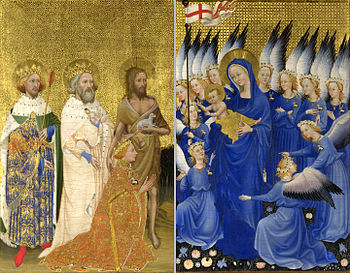
http://en.wikipedia.org/wiki/File:Wilton_diptych.jpg
This is a picture of a common Catholic feel, halos of light around the highlighted figures' heads and the angel wings.
The Renaissance
During the Renaissance, the people of Europe began to focus on human form and nature.

http://en.wikipedia.org/wiki/File:Vitruvian.jpg
The Vitruvian Man is a fine example of the focus on human anatomy. By Leonardo Da Vinci, it describes the proportions of a human (which many can be described as PHI).
The Renaissance in Northern Europe
At first, the Renaissance in the North focused mainly on religious affairs in art. Later, they focused instead of the concepts of their daily lives.
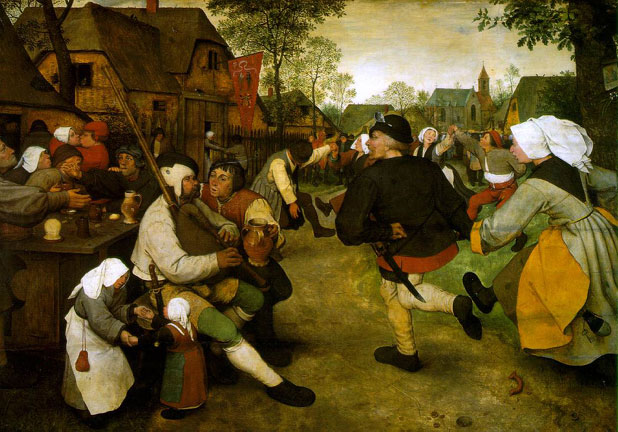
http://www.robinurton.com/history/Renaissance/BrueghelPeasantDance.jpg
This is a portrait of how the peasants made their free time and got down and boogied. It is an example of the later art in the Renaissance, focusing on daily lives.
The 1600's and 1700's
Around this time, Baroque became the common style of art. Baroque was known for its exaggeration to evoke emotion to the viewer.
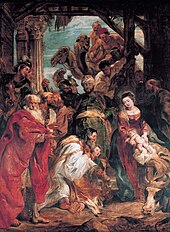
The show of Jesus Christ as a baby, Virgin Mary, and the Magi also show how the Church encouraged this style so they could a better impression through art. The faces and poses of the people in this painting make a noticeable exaggeration of drama.
The 1800's and 1900's
The 20th century began to show interest in abstract, geometric design, and twisting the colors. Cubism, Fauvism, and Post-Impressionism were the most dominant examples of the time.
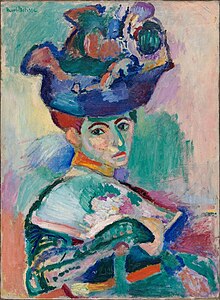
http://upload.wikimedia.org/wikipedia/en/thumb/f/fb/Matisse-Woman-with-a-Hat.jpg/220px-Matisse-Woman-with-a-Hat.jpg
This is an example of Fauvism; it consists of bright colors that mysteriously seem to mix well together. Henri Matisse was know best for this line of work, and started a long chain of Fauvism that still goes today.
Contemporary Art
Today's art has made a huge leap forward. Today's art seems to correspond with pop culture, and it has been commonly suggested that fine art is fading.
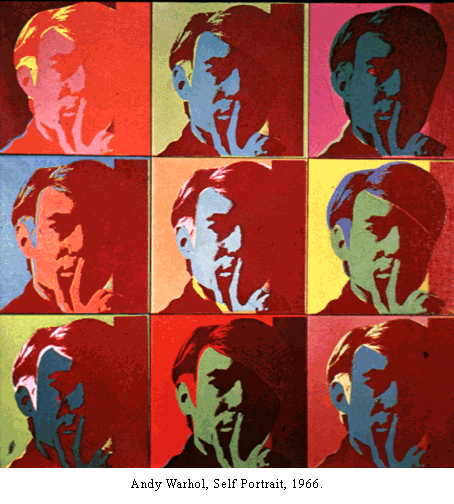
http://char.txa.cornell.edu/art/fineart/modernus/sport.gif
This is what is referred to as pop art. It is common to see a person face made into many different colors and repeated over and over. It is a fine example for how art follows popular culture.
 symbol is enclosed by a house-shaped polygon, which builds on the point that it sells household products and architecture products. The slogan below it also builds on the point that the symbol makes. Therefore this representation is effective in portraying the company's purpose.
symbol is enclosed by a house-shaped polygon, which builds on the point that it sells household products and architecture products. The slogan below it also builds on the point that the symbol makes. Therefore this representation is effective in portraying the company's purpose. symbol is enclosed by a house-shaped polygon, which builds on the point that it sells household products and architecture products. The slogan below it also builds on the point that the symbol makes. Therefore this representation is effective in portraying the company's purpose.
symbol is enclosed by a house-shaped polygon, which builds on the point that it sells household products and architecture products. The slogan below it also builds on the point that the symbol makes. Therefore this representation is effective in portraying the company's purpose.

 http://en.wikipedia.org/wiki/File:Wilton_diptych.jpg
http://en.wikipedia.org/wiki/File:Wilton_diptych.jpg  http://en.wikipedia.org/wiki/File:Vitruvian.jpg
http://en.wikipedia.org/wiki/File:Vitruvian.jpg http://www.robinurton.com/history/Renaissance/BrueghelPeasantDance.jpg
http://www.robinurton.com/history/Renaissance/BrueghelPeasantDance.jpg 
 http://upload.wikimedia.org/wikipedia/en/thumb/f/fb/Matisse-Woman-with-a-Hat.jpg/220px-Matisse-Woman-with-a-Hat.jpg
http://upload.wikimedia.org/wikipedia/en/thumb/f/fb/Matisse-Woman-with-a-Hat.jpg/220px-Matisse-Woman-with-a-Hat.jpg  http://char.txa.cornell.edu/art/fineart/modernus/sport.gif
http://char.txa.cornell.edu/art/fineart/modernus/sport.gif